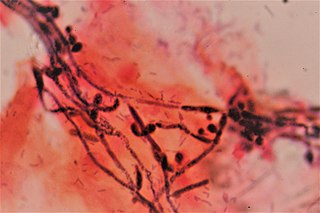
Tinea cruris, also known as jock itch, is a common type of contagious, superficial fungal infection of the groin and buttocks region, which occurs predominantly but not exclusively in men and in hot-humid climates.

Seborrhoeic dermatitis, sometimes inaccurately referred to as seborrhoea, is a long-term skin disorder. Symptoms include red, scaly, greasy, itchy, and inflamed skin. Areas of the skin rich in oil-producing glands are often affected including the scalp, face, and chest. It can result in social or self-esteem problems. In babies, when the scalp is primarily involved, it is called cradle cap. Dandruff is a milder form of the condition without inflammation.

An antifungal medication, also known as an antimycotic medication, is a pharmaceutical fungicide or fungistatic used to treat and prevent mycosis such as athlete's foot, ringworm, candidiasis (thrush), serious systemic infections such as cryptococcal meningitis, and others. Such drugs are usually obtained by a doctor's prescription, but a few are available over the counter (OTC).

Athlete's foot, known medically as tinea pedis, is a common skin infection of the feet caused by a fungus. Signs and symptoms often include itching, scaling, cracking and redness. In rare cases the skin may blister. Athlete's foot fungus may infect any part of the foot, but most often grows between the toes. The next most common area is the bottom of the foot. The same fungus may also affect the nails or the hands. It is a member of the group of diseases known as tinea.

Terconazole is an antifungal drug used to treat vaginal yeast infection. It comes as a lotion or a suppository and disrupts the biosynthesis of fats in a yeast cell. It has a relatively broad spectrum compared to azole compounds but not triazole compounds. Testing shows that it is a suitable compound for prophylaxis for those that suffer from chronic vulvovaginal candidiasis.

Dermatophytosis, also known as ringworm, is a fungal infection of the skin. Typically it results in a red, itchy, scaly, circular rash. Hair loss may occur in the area affected. Symptoms begin four to fourteen days after exposure. Multiple areas can be affected at a given time.

Haloprogin is an antifungal drug used to treat athlete's foot and other fungal infections. It is marketed in creams under the trade names Halotex, Mycanden, Mycilan, and Polik.

Bifonazole is an imidazole antifungal drug used in form of ointments.

Isoconazole is an azole antifungal drug and could inhibit gram positive bacteria. For foot and vaginal infections, isoconazole has a similar effectiveness to clotrimazole. Isoconazole nitrate may be used in combination with corticosteroid diflucortolone to increase its bioavailability.

Clotrimazole, sold under the brand name Lotrimin, among others, is an antifungal medication. It is used to treat vaginal yeast infections, oral thrush, diaper rash, tinea versicolor, and types of ringworm including athlete's foot and jock itch. It can be taken by mouth or applied as a cream to the skin or in the vagina.
Whitfield's ointment is an acidic ointment used for the topical treatment of dermatophytosis, such as athlete's foot. It can have a slight burning effect that goes away after a few minutes. It is named after Arthur Whitfield (1868–1947), a British dermatologist.

Neticonazole (INN) is an imidazole antifungal for the treatment of fungal skin infections.

Abafungin (INN) is a broad-spectrum antifungal agent with a novel mechanism of action for the treatment of dermatomycoses.

Tinea incognita or Tinea incognito is a fungal infection of the skin masked and often exacerbated by application of a topical immunosuppressive agent. The usual agent is a topical corticosteroid. As the skin fungal infection has lost some of the characteristic features due to suppression of inflammation, it may have a poorly defined border and florid growth. Occasionally, secondary infection with bacteria occurs with concurrent pustules and impetigo.

Vaginal yeast infection, also known as candidal vulvovaginitis and vaginal thrush, is excessive growth of yeast in the vagina that results in irritation. The most common symptom is vaginal itching, which may be severe. Other symptoms include burning with urination, a thick, white vaginal discharge that typically does not smell bad, pain during sex, and redness around the vagina. Symptoms often worsen just before a woman's period.
Econazole/triamcinolone is a combination drug, consisting of econazole and triamcinolone.
Microsporum nanum is a pathogenic fungus in the family Arthrodermataceae. It is a type of dermatophyte that causes infection in dead keratinized tissues such as skin, hair, and nails. Microsporum nanum is found worldwide and is both zoophilic and geophilic. Animals such as pigs and sheep are the natural hosts for the fungus; however, infection of humans is also possible. Majority of the human cases reported are associated with pig farming. The fungus can invade the skin of the host; if it is scratched off by the infected animal, the fungus is still capable of reproducing in soil.

Eberconazole is an antifungal drug. As a 1% topical cream, it is an effective treatment for dermatophytosis, candidiasis, and pityriasis.
Clotrimazole/betamethasone dipropionate, sold under the brand name Lotrisone among others, is a topical medication used for the treatment of fungal infections of the feet, groin, and body in people 17 years of age and older. It is a combination of clotrimazole and betamethasone dipropionate. It is applied to the skin.
Topical antifungaldrugs are used to treat fungal infections on the skin, scalp, nails, vagina or inside the mouth. These medications come as creams, gels, lotions, ointments, powders, shampoos, tinctures and sprays. Most antifungal drugs induce fungal cell death by destroying the cell wall of the fungus. These drugs inhibit the production of ergosterol, which is a fundamental component of the fungal cell membrane and wall.
The Merck Index, 12th Edition. 4247














